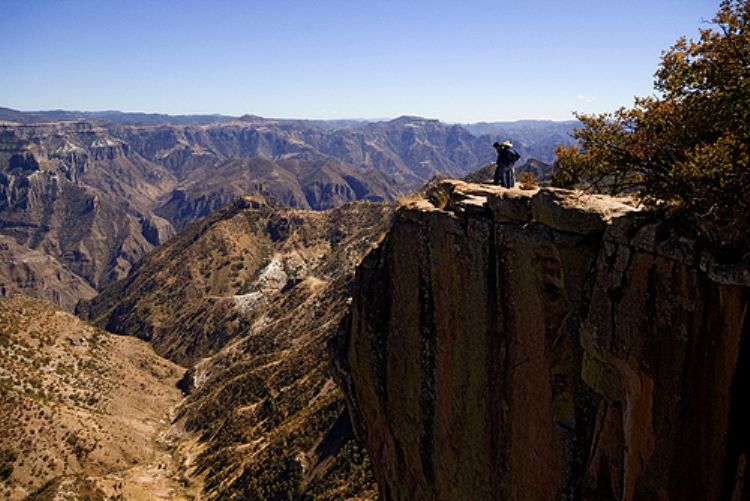Mexico's 13 Natural Wonders

The natural Wonders of Mexico are unlimited, however, after a public poll, a television station made it possible to name the 13 wonders. Winning the most votes was Barranca del Cobre in the State of Chihuahua. It is a system of ravines of great depth belonging to the Sierra Tarahumara, named Urique, Sinforosa, Batopilas, Candameña, Río Mayo and Oteros, among others.
The ravines also originate one of the countrys most important hydrological systems; Fuerte, Mayo and Yaqui Rivers.
The most famous route is offered by the train system from Chihuahua to the Pacific Ocean, the system is enriched by enormous waterfalls like Piedra Volada and Basaseachi, with 453 and 246 meters approximately.
<
Cuatro Ciénegas is the second wonder, in the State of Coahuila. A protected valley for the endemic subspecies of flora and fauna, like some species of turtles and the âblind fishâ. The waters of Cuatro Ciénegas contain a type of algae coralline with a bluish characteristic. The place also gathers endemic species, habitat in which water species live in the middle of a desert climate.
The Cañón del Sumidero in Chiapas, is the third Mexican wonder that can be accessed by its viewpoints: Los Chiapa, El Tepehuaje, El Roblar, La Coyota and La Ceiba, from Tuxtla Gutierrez. Although there is no precise data on its height, it is estimated to be around 1,400 meters.
This geological fault forming the great canyon is decorated by the rbol de Navidad (Christmas Tree) waterfall, owing its name to its exuberance and appearance.
On the fourth place of Mexicoâs wonders is Pinacate, a desert portion with craters in the State of Sonora, a protected reserve for its landscape beauty and biological wealth. Hundreds of animals and plants survive there despite the extreme climate conditions. The craters characteristic of the zones El Badillo, El Molino, El Cerro Colorado, El Volcán Grande, El Cráter McGougal and El Carvalajal offer a unique landscape inhabited by bighorn sheep, pronghorn antelopes and diverse vegetable species like the saguaro.
The Sótano de las Golondrinas (Barn Swallow Basement) in San Luis Potosi is another natural wonder formed by an abyss 376 meters deep. Inhabited by diverse species of birds like common swifts and parrots leaving every day at dawn and returning at dusk.
The Peña de Bernal, in Queretaro, is one of the largest monoliths in the world, more than 300 meters high, its magnitude can be observed from many kilometers away. It is the remains of a solidified volcano.
Los Pantanos de Centla (Centla Swamps) in Tabasco is one of the most important wetlands in the continent. A site with the intersection of the rivers Grijalva, Usumacinta, San Pedro, Champan, Las Cruces and Las Piñas, among others. It has a rich variety of amphibians, mammals, reptiles, fishes and plants.
Another great natural wonder in our country is the basaltic prisms in the State of Hidalgo, rocky formations thousands of years old made of basalt prisms originated by abrupt lava cooling. The construction of a dam complements the waterfall that covers these geometric figures.
The State of Jalisco is the emblematic site in the production of blue agave for producing the Mexican tequila, the national drink. The blue color of the agave (tequilana Weber) is due to the content of waxes that protect the plant from humidity loss.
The ecological park El Arrecifal in Veracruz is the tenth wonder of Mexico, considered as such for the beauty of its corral systems it shares with the Municipalities of Veracruz, Boca del Río and Alvarado. Some reefs are: Hornos, Lizardo, Punta Antón, Punta gorda, Galleguilla, Blanquilla, Anegada de Adentro, Bajo Paducah, Verde, Chopas and Polo, among others, with more than 30 coralline species and an extension of more than 52 thousand hectares.
The Biosphere Reserve El Cielo in Tamaulipas represents the eleventh wonder of our country. It is part of the Municipalities Gómez Farías, Llera, Ocampo and Jaumeve, since it is an enormous geographic portion reaching from the tropical forest to the brushes and water vegetation. The denomination El Cieloâ is not exaggerated, since this reserve is shared by a great number of terrestrial and water ecosystems. The Oriental Sierra Madre in combination with the tropical climate originates environments and systems in transition. In it are springs, caves and spaces colored by endemic vegetation and birds, reptiles and mammals.
The sanctuary of the Monarch Butterfly is a traditional site of Michoacán, where millions of butterflies arrive during the last months of the year after a trip of more than four thousand kilometers, from the forests of Canada and United States for reproducing and returning in April. This journey makes it necessary to feed and keep safe from predators; they obtain this from the properties of the toxic plants they eat, making them repulsive to predators. Their stay contributes to the pollination of the plants in the forests of Zitacuaro, Angangueo and forests of Michoacan bordering with the State of Mexico.
The last Mexican wonder considered as such in this list is Xel-Ha, in Quintana Roo. It is considered one of the largest and most spectacular natural aquariums in the world. If offers mutltiple ecological activities and that puts people in an intimate touch with nature.
Mexico also has hundreds of natural attractions in all its States, for the diversity of its climate, flora and fauna forming admirable ecosystems.
Click on the PLAY button to watch the Video.
Artículo Producido por el Equipo Editorial Explorando México.
Copyright Explorando México, Todos los Derechos Reservados.






